If all that glitters isn't gold, could it be Silver? Sterling silver - Collectible or commodity?
written by Valerie Hammond
For centuries the world has been mesmerised with shiny objects and precious metals. Diamonds used to be “a girl's best friend” and a person was thought to be wonderful if they were “worth their weight in gold“. But we also had “the silver screen“, “served on a silver platter“ and, of course, “look for the Silver Lining“ plus many other notable quotes about this wondrous metal.
Gold, shiny bright and very expensive. So, if all that glitters is not gold, could it be silver? Silver, a precious metal, shiny, bright and far more affordable.
Tea set by Peter Carl Fabergé, made before 1896, silver gilt and opaque cloisonne enamel, Cleveland Museum of Art. Image: Public Domain
Sterling silver, medical marvel
Silver has always been far more versatile and functional. Used for everything from dinner services in the royal households and wealthy estates, to Fabergé eggs, and Grandmas’ egg cups, and of course jewellery. Silver is decorative and elegant, and today, an affordable precious metal. We’ve all heard the expression “born with a silver spoon in his mouth“. A little known fact about sterling silver is that it has wonderful anti-germ properties. Children who were fed with silver spoons were much healthier than those fed with pewter. So, over the decades and centuries, the connection of health and wealth became a belief that a rich family was a healthy one. Being born with a silver spoon in one's mouth evolved into a generic term for rich.
In fact the anti-germ properties of silver were so important that, during World War I, silver compounds were administered to the troops to prevent infections from spreading. Because of that, many cultures believe that silver has special powers and helps to ward off evil and illness. Some of these old tales are based on fact.
Related: How To Value Silver & Metals
Did you know? That in 151 languages the word for silver is the same as the word used for money.
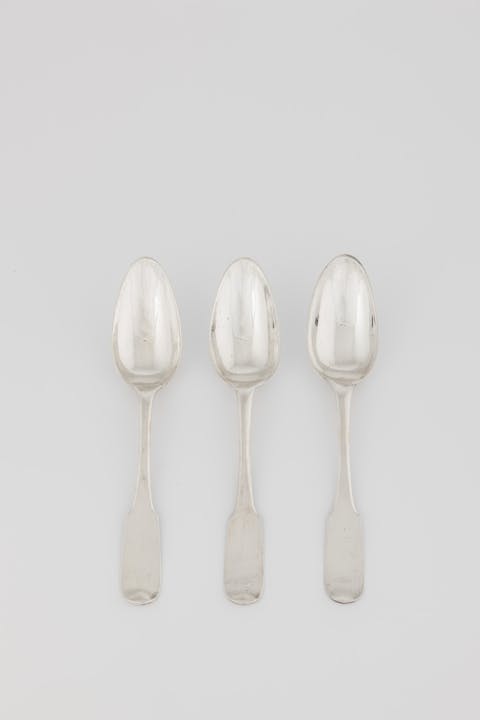
Three silver spoons by Peter Streissel, 1797, Münchner Stadtmuseum Image: Patricia Fliegauf, Ernst Jank / License: CC BY-SA 4.0
"Children who were fed with silver spoons were much healthier than those fed with pewter. So, over the decades and centuries, the connection of health and wealth became a belief that a rich family was a healthy one. Being born with a silver spoon in one's mouth evolved into a generic term for rich."
Sterling silver, affordable everyday elegance
In today's world of fast foods, microwaves and convenience, we are more likely to eat standing up in the kitchen and from a microwavable bowl, than to sit at a formally set dining table with linens, fine china and crystal and silver salvers and serving trays. Because of the lack of demand , and the exceptionally high price of gold, sterling silver has become a viable precious metal commodity for more people.
Sterling tea sets, hollowware items, flatwares, decorative works , candle holders etc, are now more affordable, and thanks to the vast number of antique and vintage venues and of course the internet, it is more easily found than ever before.
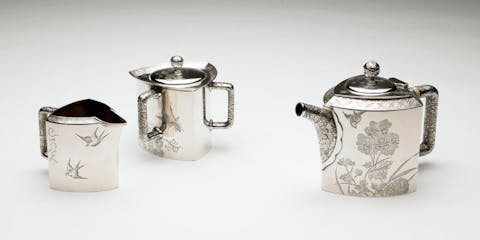
Silver and ivory tea set by Tiffany & Company. Left to right: creamer, sugar bowl, teapot, c. 1877, held at theBirmingham Museum of Art. Image: Sean Pathasema / License: CC BY 3.0
While few of us can invest in the purchase of gold coins or bars, a pre owned sterling silver is possible, and, unlike a lot of things, these are functional and good investments. A precious metal may fluctuate in values but it never loses its value totally the way a Beanie Baby or collectors plate does. Buying silver doesn’t mean that you need to buy large pieces you will never use, and only store away until you need to sell it. Sterling silver is a commodity as well as a consumer durable, and it is never a mistake to buy when prices are lower and income allows.
In the realm of pre-owned silver, the fastest growing segment of silver sales is vintage sterling silver jewellery. Small, easy to find, easy to store and affordable at all resale levels.
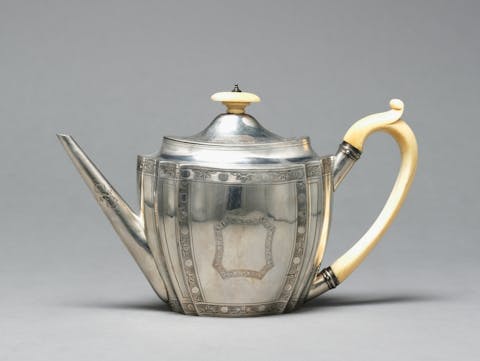
Teapot, 1795. Firm of George Smith (British), firm of Thomas Hayter (British). Silver and ivory; overall: 16.5 x 27.7 x 10.7 cm (6 1/2 x 10 7/8 x 4 3/16 in.). The Cleveland Museum of Art, Gift of Vera G. Kinsler in honor of grandchildren Garth and Stephanie Robins 1984.48
Sterling silver jewellery
Silver is such a functional metal, malleable, it can be molded, engraved, embossed, plated over base metals, covered with gold , overlaid on glass and porcelain, and was once even used to fill teeth. Sterling silver jewellery has been made all around the world for centuries (since at least 4000 BC). We have seen a huge increase in the popularity of sterling silver jewellery since the new Millenium.
In particular Mexican Sterling silver and Native American designs from the Pueblos and Navajo, Zuni and Hopi tribes. Scandinavian sterling from the likes of Georg Jenesen, Ole Lyngaard, Hans Hansen are in high demand, and that demand is reflected in the much higher prices we see for vintage Scandinavian (primarily Danish) designs. Mexican jewellery has for the most part been largely ignored by collectors, in the belief that it is not the same quality as jewellery made elsewhere. Nothing could be further from the truth.

Thorvald Bindesbøll (Danish, 1846-1908), Vase, firm of Anton Michelsen (Danish), Sterling Silver, 1900, The Cleveland Museum of Art, Image: John L. Severance / License: Public Domain
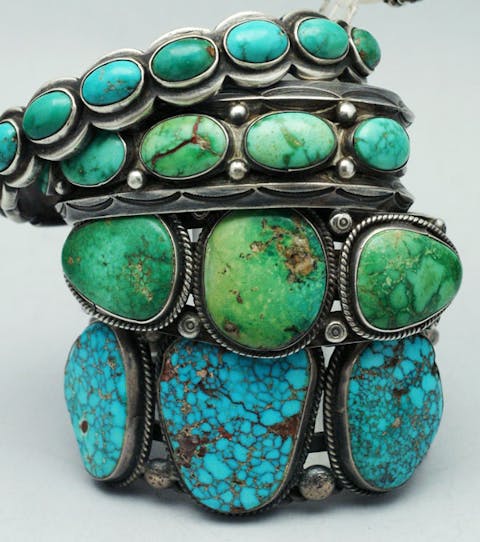
Navajo bracelets in sterling silver set with turquoise stones. Image: Silverborders / License: CC BY 3.0
"Mexican jewellery has for the most part been largely ignored by collectors, in the belief that it is not the same quality as jewellery made elsewhere. Nothing could be further from the truth. "
Vintage Mexican and Native American jewellery was handcrafted by skilled artisans working in small jewellery studios. In the early 20th century the finest designers in the United States travelled to Mexico to work in those studios and small factory locations, to hone their skills and learn from the masters.
The Taxco province of Mexico is to silversmithing what the Cinque Ports were to trade and commerce, and what Staffordshire was to the pottery and ceramics industries, Limoges was to French porcelain and Bohemia was to glassmaking.
Some of the most prestigious designers of the 1930s gained the knowledge and techniques under the mentoring of fine Mexican silversmiths.
Did you know? An ice cube will melt faster on silver than on base metal. The faster the melt, the higher the purity of silver!
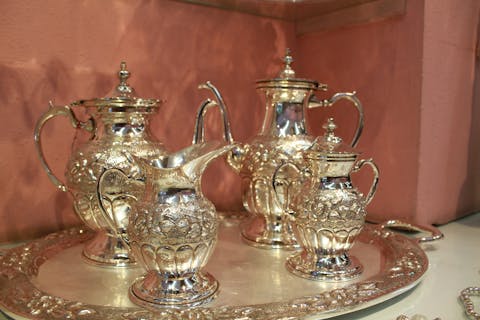
Coffee and Tea service, en example of Taxco silverwork. Image: Gerardo Dávalos Ocampo / License: CC BY-SA 3.0
Did you know? Today, Mexico is the world's leader in silver production. Number One They produced almost 6,000 metric tons of silver in 2021.
Pre-owned silver, the treasure hunt
Finding antique and vintage silver of all kinds is easier today than it has ever been, thanks to the abundance of professional antique and vintage dealers, antique fairs, estate sales, consignment shops, markets and of course on line sales.
When we speak about silver in this article, we are not referring to silver plated items. Although silver plate is reclaimable, it is a costly process, so scrap dealers or dealers in melt value silver will often show little interest in plated items. Silver overlay is also very difficult to reclaim so for the same reasons, its best to only buy those items because you love them and not for melt values.
They are often highly decorative, and companies such as Alvin Art Glass can be worth as much as 6,000 GBP ( over 7000 Euros ) depending on the colour , size and form. Since many of us just don't have the room for large sterling silver tablewares, tea sets, chargers, domed meat trays etc, and because of the sheer weight, the prices can be daunting if you are just learning about silver, the best way to start to collect is to start small. Here the jewellery is the perfect option.
Did you know? If you are buying to scrap items, auctions and markets often sell damaged pieces, sterling lids, mismatched flatware, engraved or monogrammed items ,a single candle holder, flasks, etc and generally they are within reasonable price points. Those are perfect for investment purposes.
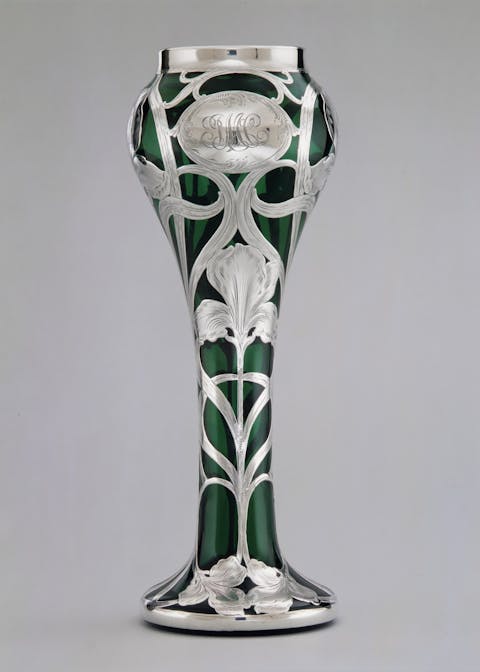
Green vase with sterling silver overlay by The Alvin Manufacturing Company, 1890-1905. Image: Public Domain
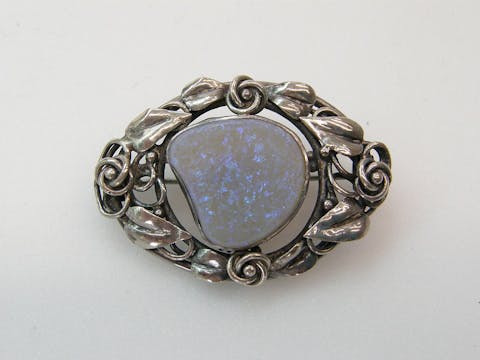
Oval brooch in sterling silver set with irregularly-shaped flat opal cabochon opal, 1920's. Image: Auckland Museum/ License: CC BY 4.0
Once you have decided that you would like to invest in silver, knowing how to care for it and store it is important. If you take good care of it, there is always the possibility of selling your pieces to a dealer in antique sterling. Dealers have a much broader market base for the larger home decor items and will pay based on age and condition as opposed to seeing your lovely flatware as 6 kg of melted silver. There is a difference between a scrap dealer and an antique dealer. Antique dealers understand the importance and intrinsic value and history of an item, whereas a scrap dealer only sees the monetary values.
How does silver make the grade?
Silver Grades start at 800 right up to pure silver 99.9% The higher the grade the softer the silver. The 99.9% grade is reserved for commercial industrial use, and not for manufacturing because it is too soft. Even the silver used on the silver plate is sterling silver.
Did you know? The strips used to defrost vehicle windows are sterling silver ? One ounce of silver can be extruded to produce a wire 8,000 feet long.
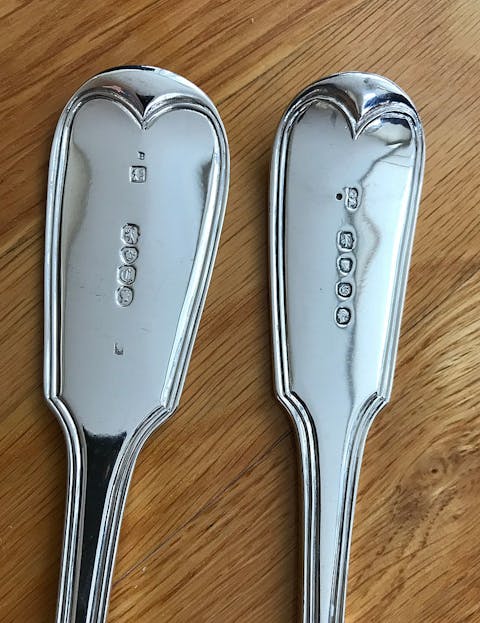
The hallmarks on two pieces of English silver cuttlery (from the workshops of George Adams (1842) and Joseph & Albert Savory (1838). Each piece has a tally mark added (the letter B on one and a small dot on the other). Both pieces also have a Duty Mark (Queen Victoria). Image: Grenadille / License: CC BY-SA 4.0
Save the plastic wrap for the food on your silver trays
To protect your silver, store it in a cool dry place. Wrap it in acid free tissue, or cotton muslin, and pack in paper bags. Never store or wrap any silver, not even plated items in plastic bags or plastic wrap. Plastic contains sulfur which promotes tarnish. Plastic wrap also clings to the metal and can leave marks on the surfaces which are impossible to remove. Don't store it near a heat source or humid location such as a basement, attic or garage. There are two schools of thought about cleaning silver. One for housewares and one for jewellery.
Toothpaste is perfect for cleaning, but only on your teeth
Silver serving pieces and cutlery must be polished. Avoid any abrasive cleaners which actually remove a thin layer of silver as well as oxidation tarnish. As a dealer, I do not recommend silver dips, tin foil and baking soda (abrasive), heat and moisture promote tarnish . Chemicals and air borne pollutants also increase the rate your silver will tarnish, so don't spray furniture polish on your table when the silver candlesticks are on it etc.
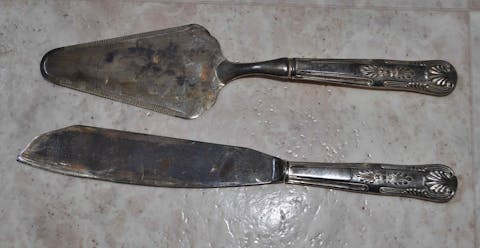
Silver cake knife and server, unpolished. The black coating is silver sulfide. Image: Public Domain
When it is stored away, one simple “green“ preventative is simple sticks of chalk. It absorbs moisture really well, another are the little packs of silica gel or beads that often come in packaged goods. They also absorb moisture.
Some people like to use non chemical cleaners, but please save your ketchup, vinegar and salt for your fish and chips, and tooth polish or paste for your teeth. They are acidic and harsh and do more harm than good in the long term. Don't polish silver plates too often. It causes wear and tear and will eventually rub through to the base metals underneath.
Did you know? If you eat a lot of healthy greens such as sprouts, cabbage, kale, spinach, or rye bread, olives and celery ( there goes tonights salad ) the sulfur in those veggies is absorbed into your body, and if you perspire, you will tarnish your silver jewellery much faster!
Sterling jewellery. To clean or not to clean that is the question ?
Again as a dealer, I do not ever clean my sterling silver jewellery, but do tell customers that I will be happy to, once they have purchased it. I feel it better to leave the patina and decades of age and history in place, and let the new owner decide. Some engraved silver just looks better with the contrasts, and the raised areas of jewellery are generally shinier due to contact with skin, clothes and surfaces. It is being polished all the time .
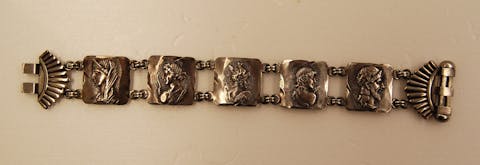
Patina on a silver bracelet by George W. Shiebler & Co. (1876–1907), ca. 1880, gift of Martha J. Fleischman, 2009. Image: Metropolitan Museum / License: Public Domain
Sterling Silver. No marks or hallmarks, does it matter?
Make sure any sterling silver you buy is hallmarked or stamped, especially if you are buying to resell at some point, or ask for a receipt stating .900 or . 925, or sterling silver etc. Some sterling is not stamped, and testing kits are available, but they use acid and are not convenient to use in a shop or resale venue. So proof in writing is your best protection when no hallmark is seen. Often Native American silver is not hallmarked but has an artisan's mark which can be researched.
Did you know? Silver plating was invented in Sheffield England in 1743. and the first process required the application of ultra thin sheets of sterling silver fused to the underlying base metal of copper. It was an accidental discovery, made when a cutler was trying to repair a knife. The silver being used for the repair to an ornate item melted and fused to the copper handle, and Eureka!
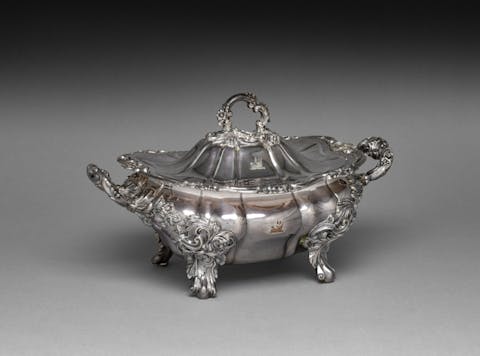
Covered Tureen, c. 1830-50. England, Sheffield. Silver plated on copper (Old Sheffield Plate); overall: 25.9 x 107 x 40.5 cm (10 3/16 x 42 1/8 x 15 15/16 in.). Image: The Cleveland Museum of Art, Bequest of Muriel Butkin
Sheffield plate is highly collectible today but it is not sterling silver. However, the invention made it possible for all classes to have gorgeous decorative and holloware items which looked like fine sterling silver, for a fraction of the cost.
Be careful of buying badly tarnished silver plated items , that dark patina can hide all kinds of damage to the plating, hiding the exposed base metals. And if you are lucky enough to have family silver now looking like fine mahogany, and you hate to clean it, do what one of my longtime customers does. She puts her great aunts candlesticks and wine carafes on the table, and tells her friends they are bronze!
Now is the season of outdoor markets, boot sales, fairs etc, and a perfect time to start your treasure hunt!
Submit your Sterling Silver for Appraisal Here!
Val Hammond has been an antique and vintage jewellery dealer since 1985. She develops courses and does guest speaking across Ontario, Canada, and conducts interactive workshops on antiques and collectables for organisations, clubs and libraries. She is a contributing writer to numerous antique journals, is an online appraiser and supplies props and jewellery for television commercials and film. Val was also the Poet Laureate for the city of North York, Ontario from 1981-83, and the first female Poet Laureate in Canada.

